What is SEO?
When you search for something on the internet, have you ever wondered how certain websites appear at the top of the results? That’s where Search Engine Optimization (SEO) plays a role.
It’s the process of improving a website’s visibility on search engines like Google, helping it rank higher when people look for relevant information.
At its core, SEO full form is Search Engine Optimization, which means making a website more accessible and relevant for users and search engines. The goal is simple when someone searches for a topic related to your business, your website should appear at the top.
SEO’s Evolution with AI and Algorithm Updates
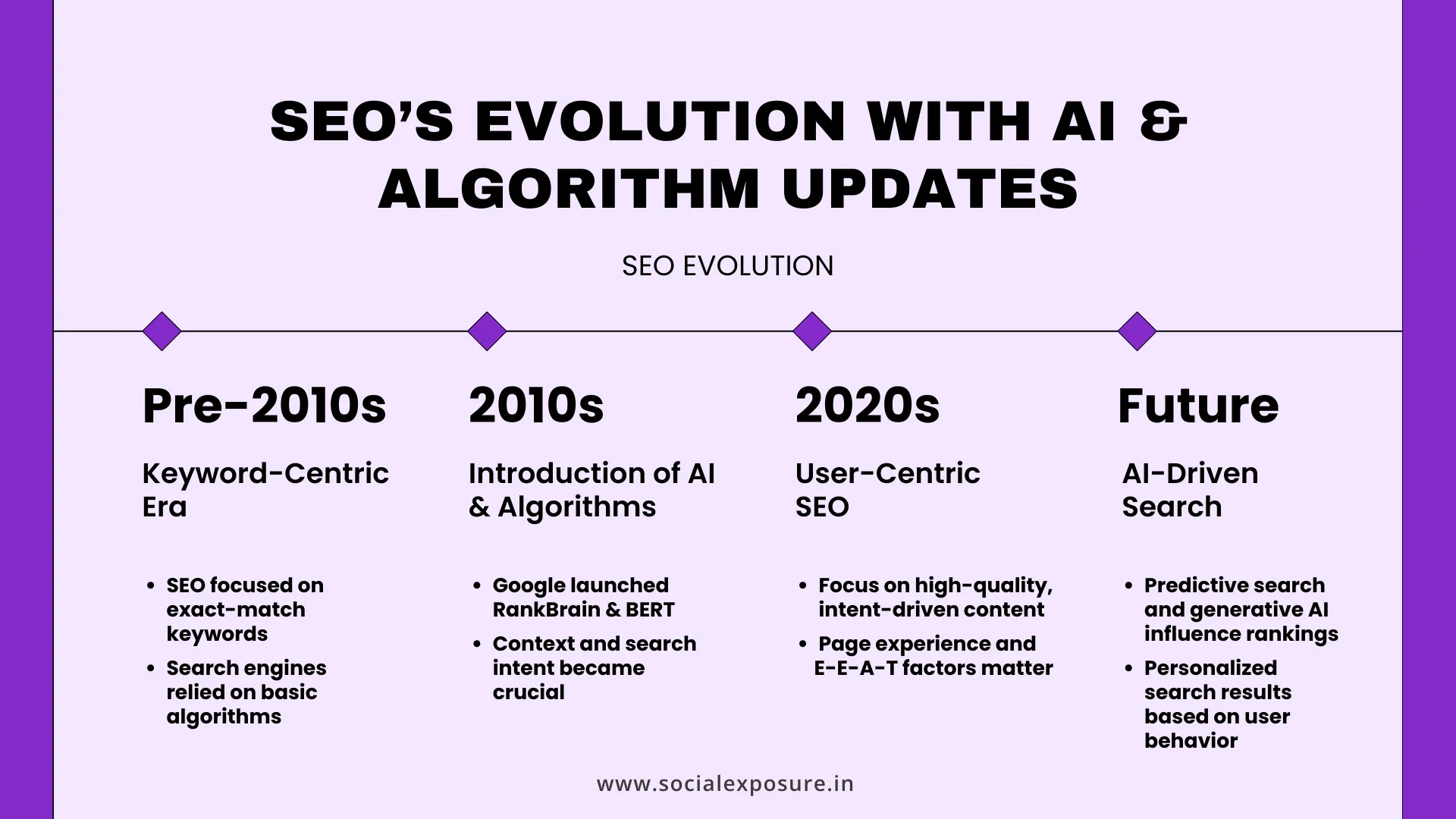
In the past, SEO was focused mainly on keyword placement. However, search engines have evolved with artificial intelligence and advanced algorithms that prioritize high-quality content. Today, factors like user intent, page experience, and trustworthiness play a major role in rankings.
SEO is no longer just about adding keywords, it’s about creating content that helps users find exactly what they are looking for. Businesses that adapt to these changes and focus on delivering value will always have a competitive edge.
Why Is SEO Important?
How SEO Increases Visibility and Credibility?
SEO’s Impact on Website Traffic
- Over 33% of all website traffic comes from organic search, making SEO one of the most valuable sources of visitors.
- Studies show that 75% of users never scroll past the first page of search results, proving how Essential it is to rank higher.
- Businesses that invest in SEO experience an increase in leads and conversions compared to those that rely only on paid ads.
SEO is not just about rankings; it’s about making sure people can find, trust, and engage with your content. Whether you’re running an online business, a personal blog, or a company website, SEO is essential for long-term success.
How Search Engines Work?
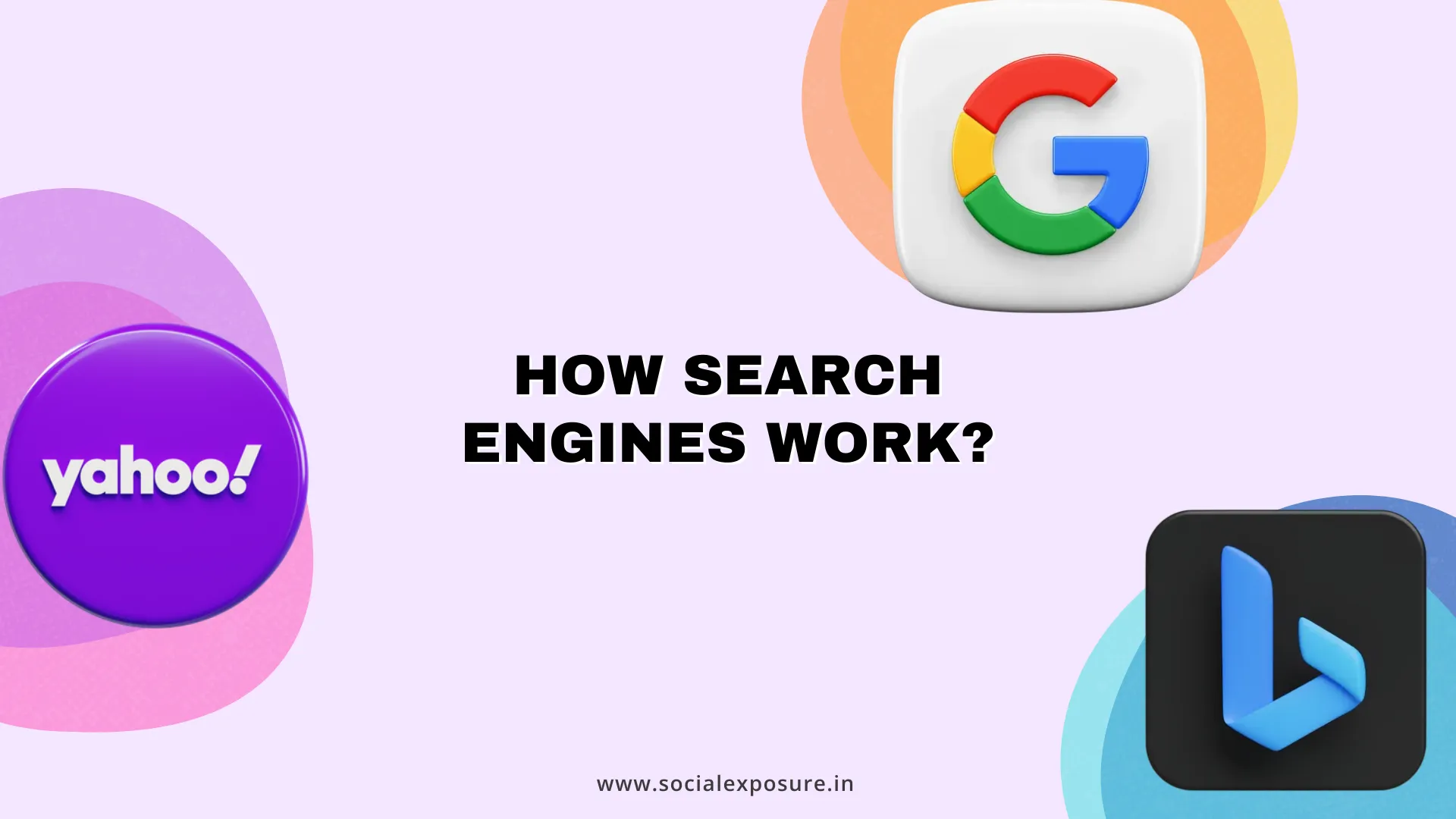
Understanding Crawling, Indexing, and Ranking
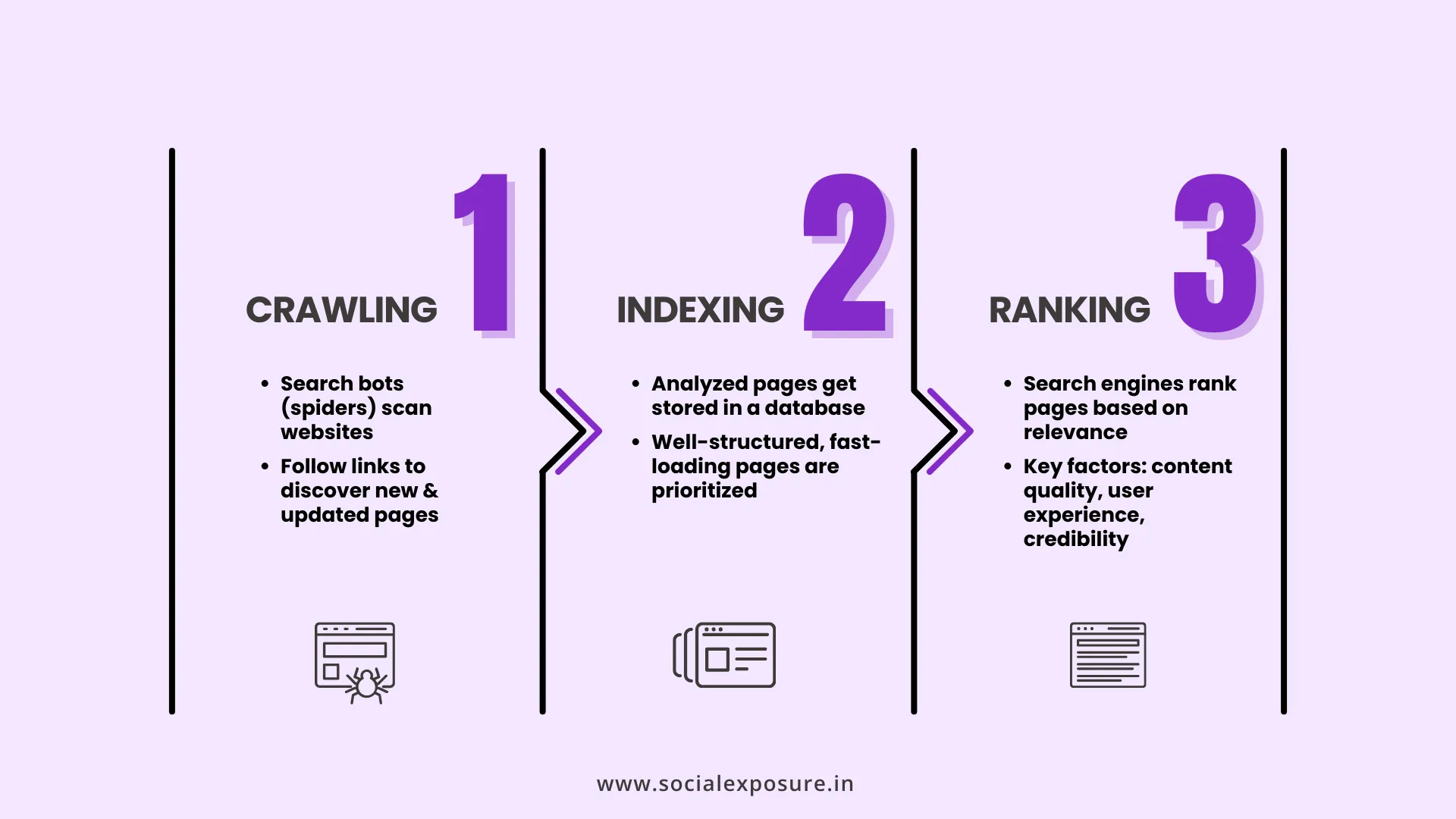
- Crawling: Search engines use bots (also called spiders) to scan web pages and collect information about their content. These bots follow links to discover new pages and updates on existing ones.
- Indexing: Once a page is crawled, search engines analyze and store its content in a vast database. Pages that are well-structured, load quickly, and contain useful information are more likely to be indexed.
- Ranking: When a user searches for something, the search engine retrieves relevant indexed pages and ranks them based on hundreds of factors, such as content quality, relevance, user experience, and credibility.
Types of Search Engines and Their Role
There are different types of search engines, including:
- Google: The most widely used search engine, with advanced AI-driven ranking systems.
- Bing: Microsoft’s search engine, which provides an alternative search experience with different ranking signals.
- Yahoo, DuckDuckGo, and Others: These focus on different aspects like privacy and niche-based results.
Each search engine has its own way of ranking web pages, but all of them prioritize delivering the best results based on user intent.
AI and Search Engine Ranking
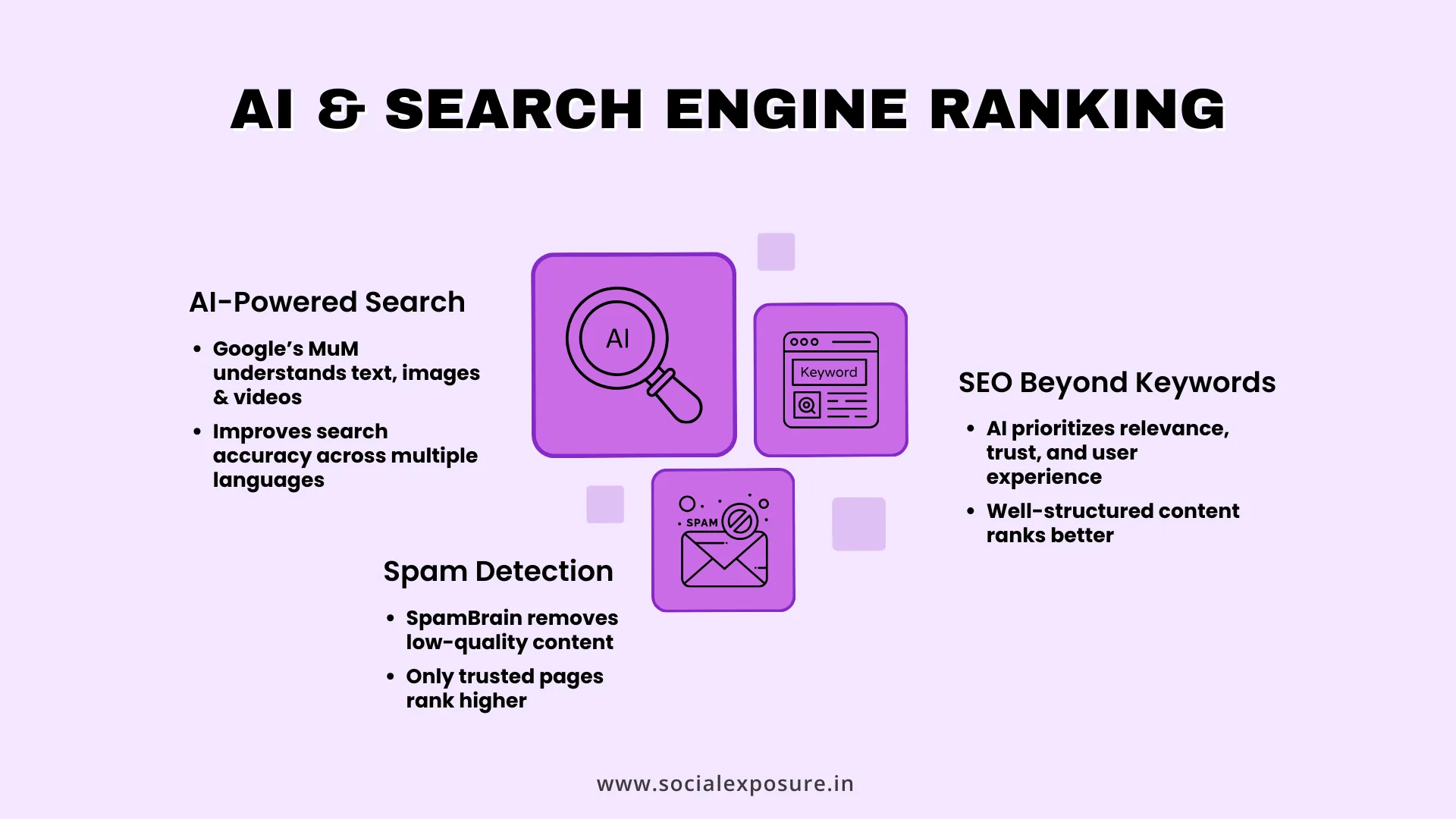
Search engines have evolved significantly. Google now uses AI-driven ranking systems like MuM (Multitask Unified Model) to understand search queries more accurately. It analyzes not just text but also images, videos, and multiple languages to provide better search results.
Additionally, SpamBrain AI detects low-quality and spammy content, ensuring that only trustworthy websites rank higher. This is why search engine optimization marketing is no longer just about keywords, it’s about creating valuable, well-structured content that search engines recognize as useful for users.
The more aligned a website is with search engines, the better its chances of getting higher ranking in search results.
Types of SEO
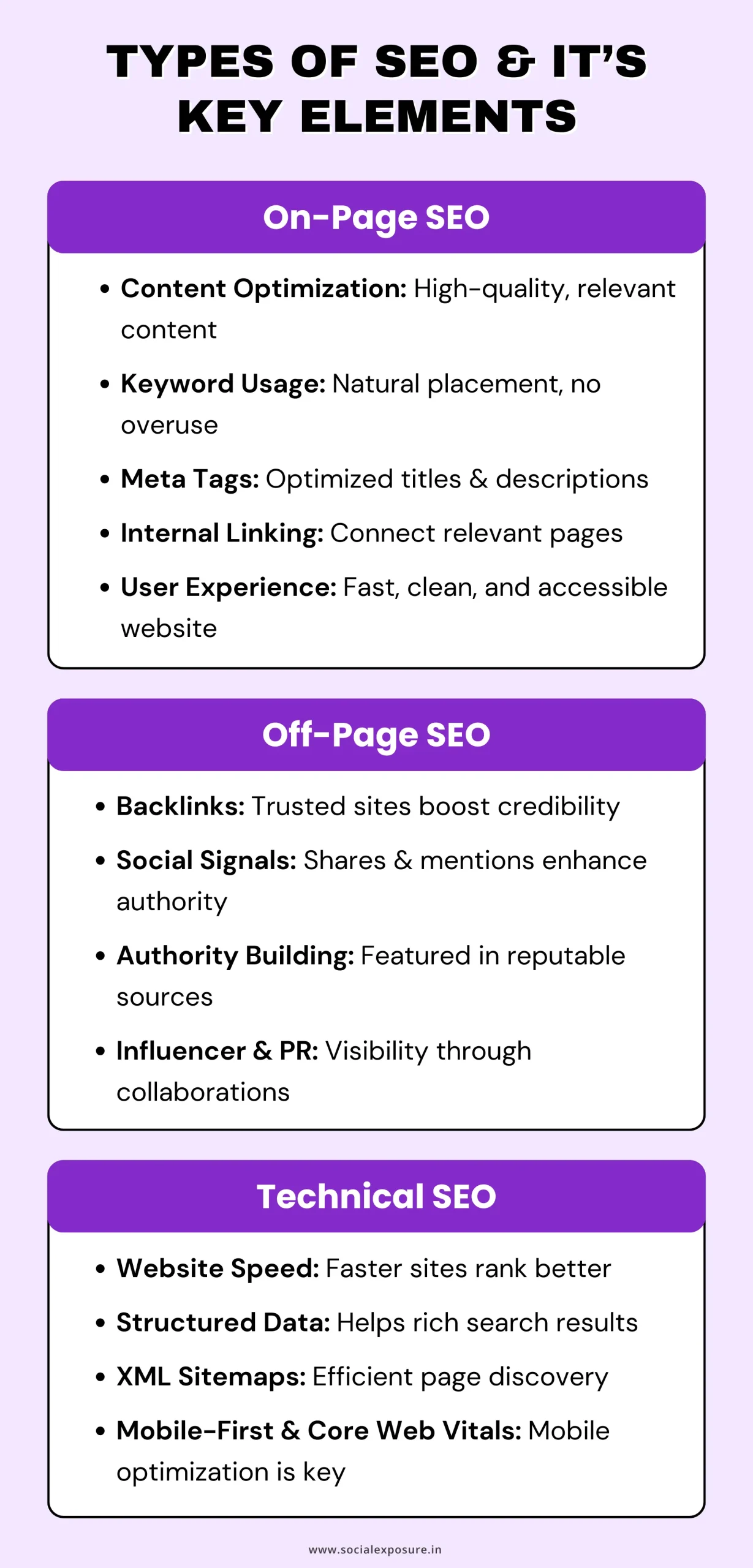
A. On-Page SEO
On-page SEO focuses on optimizing elements within a website to improve search visibility and user experience. This includes:
- Content Optimization: Writing high-quality, relevant content that provides real value to users. Well-structured articles that answer user questions tend to rank better.
- Keyword Usage: Naturally incorporating relevant keywords to match user intent while avoiding overuse.
- Meta Tags: Optimizing meta titles and descriptions to make search results more attractive to users.
- Internal Linking: Connecting related pages within a website to help users and search engines navigate better.
- User Experience: Ensuring a clean, fast-loading, and accessible website for visitors.
B. Off-Page SEO
Off-page SEO focuses on activities outside of a website that impact its ranking. This includes:
- Backlinks: Getting links from reputable websites increases credibility and signals trustworthiness.
- Social Signals: Mentions and shares on social media platforms indicate content popularity.
- Authority Building: Establishing expertise by being featured in reputable industry sources.
- Influencer Marketing & PR: Collaborating with influencers and gaining press mentions helps build recognition and search visibility.
C. Technical SEO
Technical SEO involves backend optimizations that make a website easier for search engines to understand and index. This includes:
- Website Speed: Faster-loading websites provide a better user experience and rank higher.
- Structured Data: Adding schema markup helps search engines display rich results.
- XML Sitemaps: These help search engines discover and index website pages efficiently.
- Mobile-First Indexing & Core Web Vitals: Google ranks websites based on their mobile version, making mobile optimization Essential.
Each type of SEO plays a role in improving a website’s search visibility. A well-balanced SEO strategy includes a combination of on-page, off-page, and technical SEO to achieve long-term success.
How SEO Works: Step-by-Step Process
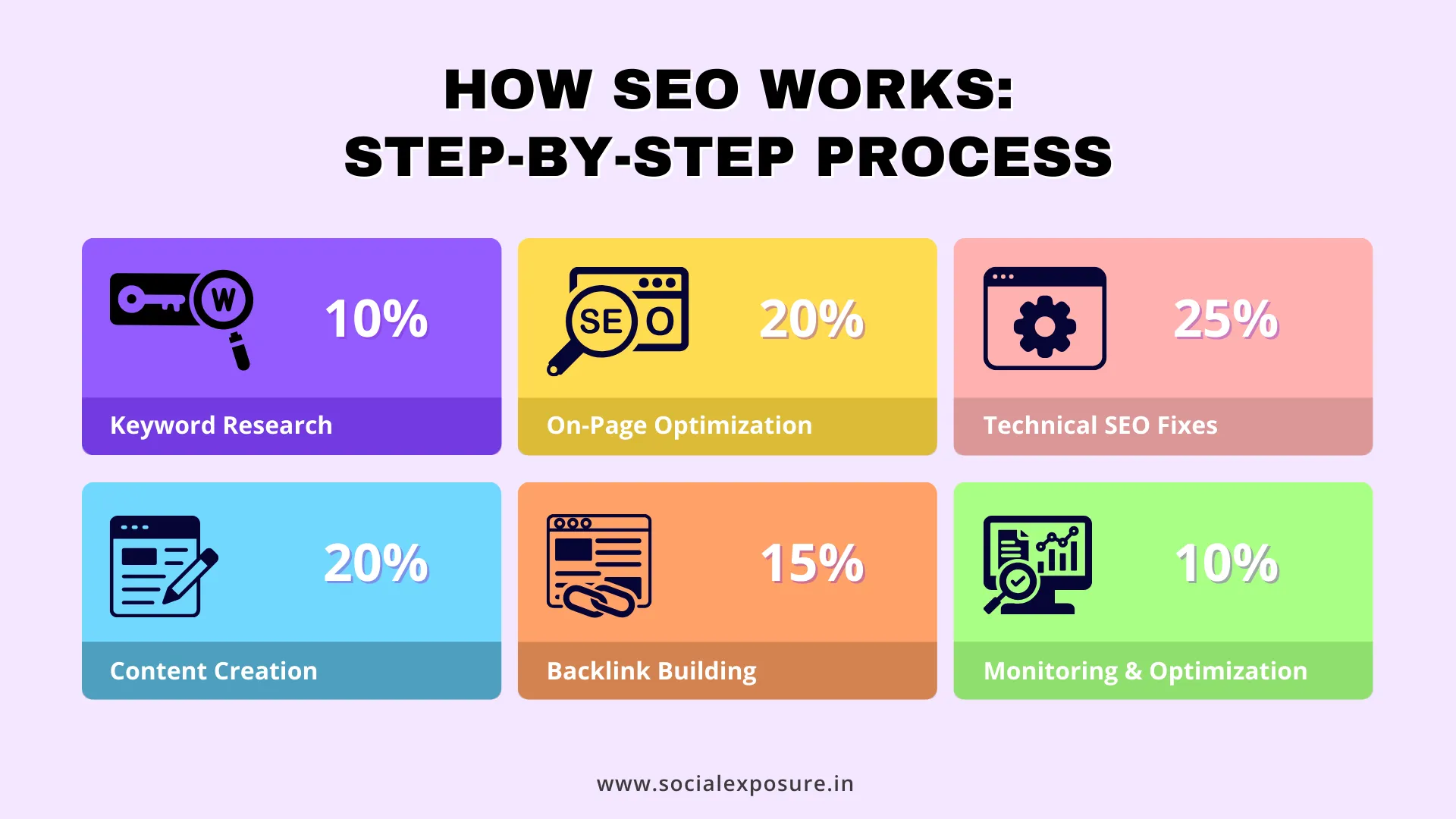
1. Keyword Research
The foundation of SEO starts with finding the right keywords. This involves:
- Identifying what users are searching for.
- Choosing words and phrases that match user intent.
- Analyzing competition and selecting keywords with high relevance and search volume.
2. On-Page Optimization
Once the right keywords are identified, the next step is optimizing the website’s pages. This includes:
- Placing keywords naturally in the content, headings, and meta tags.
- Structuring content with proper headings, bullet points, and easy readability.
- Enhancing page experience by improving navigation and design.
3. Technical SEO Fixes
A well-optimized website performs better in search rankings. Technical SEO includes:
- Page Speed: A fast-loading site improves user experience and helps with higher rankings on Google. Optimize images, use caching, and minimize code.
- Mobile Friendliness: Your site should be fully responsive and easy to navigate on mobile devices.
- Crawlability: Ensure search engines can easily access and index your pages by optimizing your site structure and using an XML sitemap.
- Duplicate Content: Avoid having the same content on multiple pages, as it can confuse search engines and lower rankings.
- Security: Use HTTPS to keep your site secure and build trust with users and search engines.
- Core Web Vitals: Focus on loading speed, interactivity, and visual stability to improve user experience and rankings.
- Structured Data: Implement schema markup to help search engines understand your content and enhance search results.
- Robots.txt: Control which pages search engines can or cannot crawl to optimize indexing.
4.Content Creation
Search engines rank pages that provide value to users. SEO explained simply means creating high-quality, informative content that answers user queries. The content should be:
- Relevant and engaging.
- Well-structured with clear sections and headings.
- Updated regularly to remain useful.
5. Backlink Building
Links from trusted sources act as endorsements for a website. To build credibility:
- Acquire links from industry-relevant and authoritative websites.
- Use guest posts, business partnerships, and social mentions.
- Focus on quality over quantity relevant links matter more than a high number of low-quality links.
6. Monitoring and Optimization
SEO is an ongoing process. Websites must be regularly monitored using tools like Google Search Console, Google Analytics, Semrush and Ahrefs to:
- Track keyword rankings and traffic.
- Identify areas for improvement.
- Make updates based on search engine algorithm changes.
By following these steps consistently, websites can improve their visibility, attract the right audience, and maintain a strong presence in search results.
Google’s Latest SEO Updates and Their Impact
Search engines continue to evolve, and what is SEO in digital marketing today is different from what it was a few years ago. Google frequently updates its algorithms to refine search results, prioritizing high-quality content while filtering out low-value pages.
Understanding these updates is Essential for businesses and content creators who want to maintain strong visibility in search rankings.
Recent Google Algorithm Updates and Their Purpose
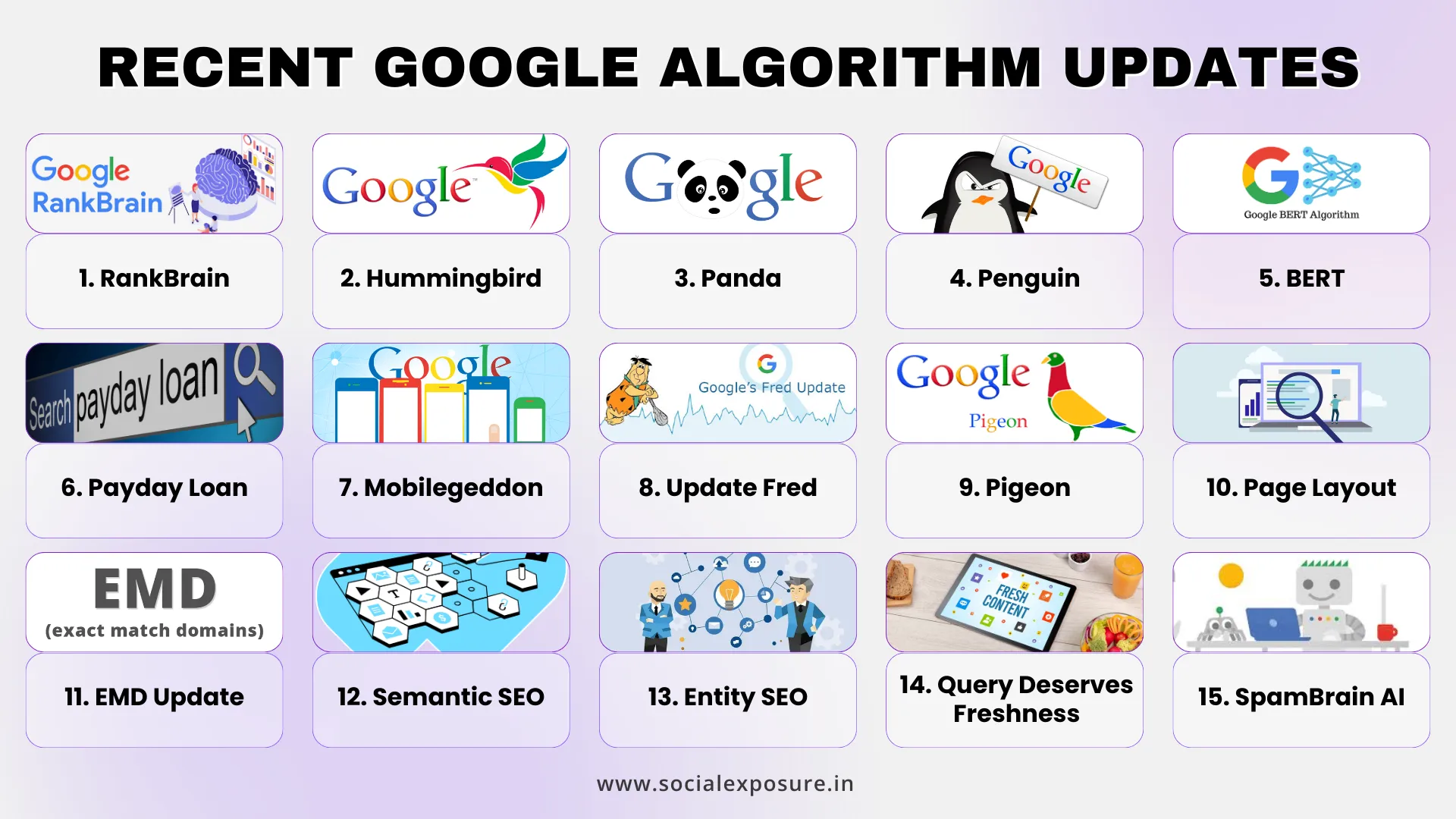
- RankBrain: An AI-driven algorithm that understands search intent and ranks pages based on relevance and user behavior.
- Hummingbird: Focuses on understanding the meaning behind queries rather than just matching keywords, improving semantic search.
- Panda: Targets low-quality, thin, or duplicate content to ensure only high-quality pages rank higher.
- Penguin: Penalizes websites using spammy backlinks or manipulative link-building tactics.
- BERT: Uses NLP (Natural Language Processing) to understand the context of words in a search query, improving search accuracy.
- Payday Loan Algorithm: Designed to combat spammy, high-risk search results, particularly in industries like payday loans and gambling.
- Mobile Update (Mobilegeddon): Prioritizes mobile-friendly websites in search rankings to enhance the mobile user experience.
- Update Fred: Targets low-value content designed solely for ad revenue, prioritizing content that provides real value to users.
- Pigeon: Enhances local search results by improving the relevance of location-based searches.
- Page Layout Algorithm: Penalizes websites with too many ads above the fold, prioritizing content visibility.
- Exact Match Domain (EMD) Update: Prevents low-quality sites from ranking solely based on keyword-stuffed domain names.
- Semantic SEO: Focuses on topic relevance, entity relationships, and intent rather than just keyword matching.
- Entity SEO: Optimizes content by focusing on entities (people, places, things) and their relationships for better context.
- Query Deserves Freshness (QDF): Prioritizes fresh content for trending and time-sensitive searches.
- SpamBrain AI: Google’s AI-powered system to detect and eliminate spam, improving search result quality.
How Google Prioritizes User-First Content
Instead of just focusing on keywords, Google evaluates content based on:
- Relevance: Does the content directly answer user queries?
- Authority: Is the website a trusted source?
- Experience: Does the content offer genuine insights and expertise?
- Engagement: Do users find the page valuable enough to stay and interact with it?
How Businesses and Content Creators Can Adapt
To stay ahead of algorithm changes and maintain rankings, businesses should:
- Focus on quality content that provides original insights and solutions.
- Ensure website performance by improving loading speed, security, and mobile-friendliness.
- Build credible backlinks from trusted sources rather than relying on spammy link-building techniques.
By understanding these updates and applying SEO best practices, businesses can ensure that their content remains visible, valuable, and aligned with Google’s evolving search standards.
Common SEO Myths and Mistakes to Avoid
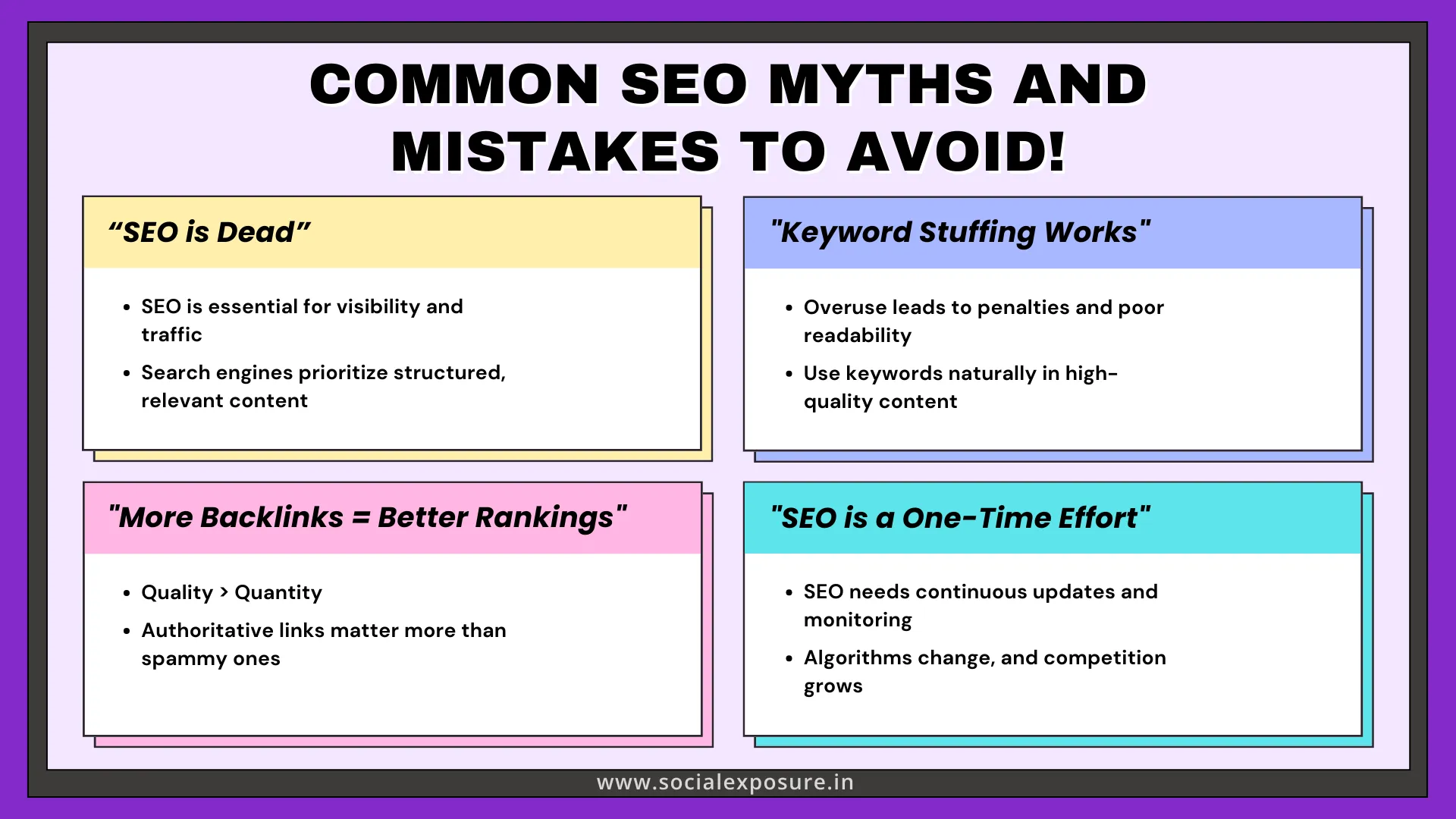
1. "SEO is Dead" – Why SEO is Still Essential
2. "Keyword Stuffing Works" – Why Overusing Keywords Hurts Rankings
3. "More Backlinks = Better Rankings" – The Truth About Link Quality
4. "SEO is a One-Time Effort" – Why SEO Requires Ongoing Work
SEO Best Practices for 2025
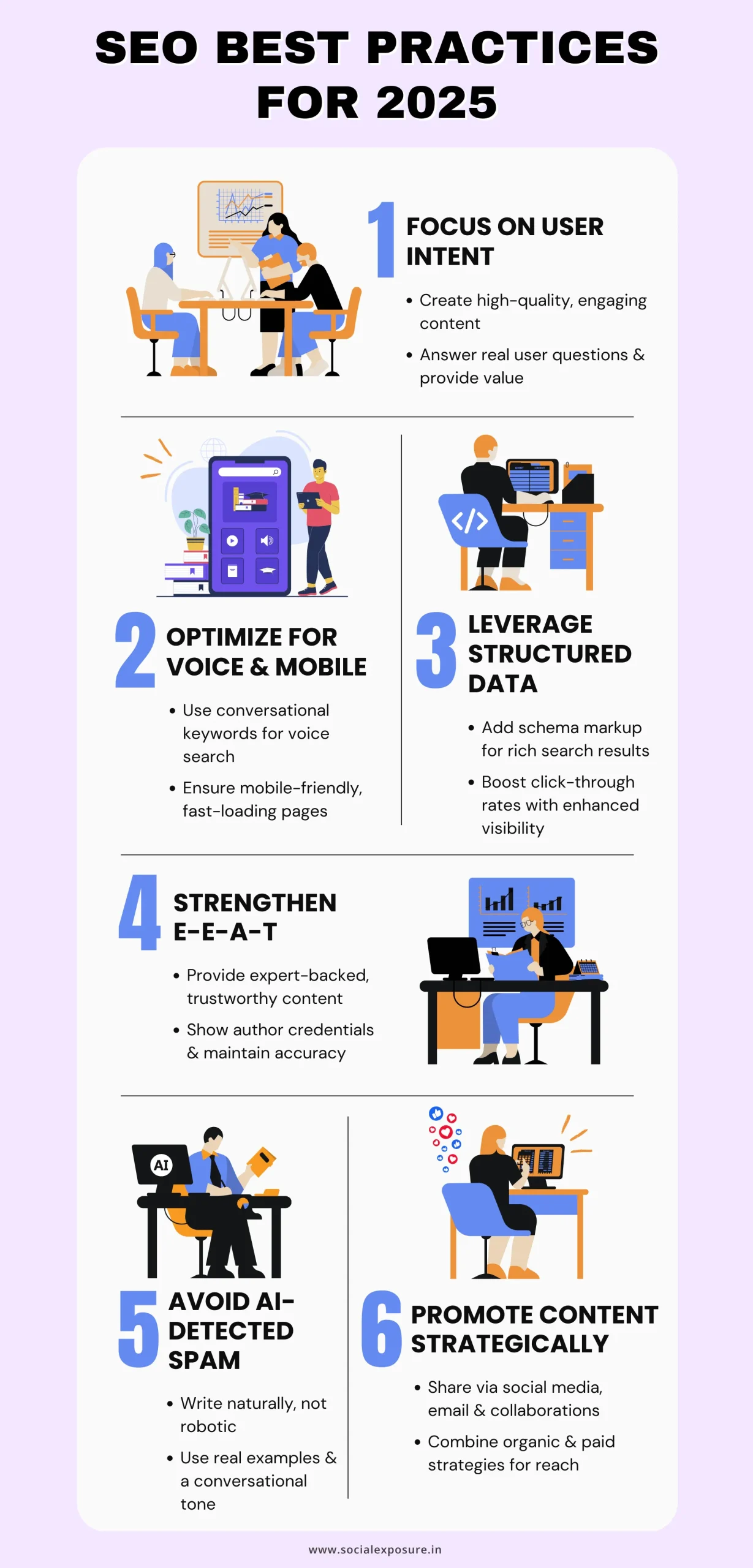
1. Create High-Quality Content That Focuses on User Intent
2. Optimize for Voice Search and Mobile SEO
With the rise of smart devices, more people are using voice search. Websites should:
- Use conversational and natural-sounding phrases to match spoken queries.
- Ensure mobile responsiveness for better rankings, as most searches now happen on smartphones.
3. Use Structured Data for Better Search Visibility
4. Build E-E-A-T: Experience, Expertise, Authoritativeness, and Trustworthiness
Search engines now assess whether a website demonstrates credibility. To strengthen E-E-A-T, businesses should:
- Provide expert-backed content with real-world insights.
- Show author credentials or expertise in their niche.
- Build trust with accurate, well-researched, and transparent information.
5. Avoid AI-Detected Spam – Write Like a Human
Google’s algorithms are now better at detecting AI-generated content that lacks originality. To ensure content remains human-like and engaging:
- Use natural writing patterns rather than predictable AI-generated phrases.
- Incorporate real examples and storytelling to keep users interested.
- Keep the tone conversational and clear instead of robotic or overly formal.
6. Promote Content Strategically
Beyond rankings, content must reach the right audience. SEO advertising and organic promotion through social media, email marketing, and collaborations can drive more engagement and traffic.
By following these SEO best practices, businesses can create content that not only ranks well but also provides real value, builds trust, and adapts to future search trends.
Conclusion
The importance of search engine optimization cannot be overstated. Whether for businesses, bloggers, or website owners, SEO marketing plays an Essential role in increasing online visibility, driving organic traffic, and building brand credibility. As search engines continue to evolve, staying updated with the latest SEO strategies is essential for maintaining strong rankings.
The key to long-term success is focusing on user-first content providing real value, answering questions, and creating a seamless browsing experience. Search engines prioritize well-structured, relevant, and engaging content over outdated ranking tactics.
For businesses looking to improve their online presence, investing in SEO marketing is no longer optional, it’s a necessity. Working with professionals like Social Exposure, recognized as one of the Best SEO Agency, can help businesses implement effective strategies that align with search engine guidelines.
By continuously adapting to search engine updates, improving content quality, and optimizing technical factors, websites can achieve sustained growth and remain competitive in search results. SEO is not a one-time effort but an ongoing process that rewards those who focus on delivering the best user experience.
Frequently Asked Questions
How long does SEO take to show results?
SEO is a long-term strategy, and results vary based on competition, website history, and effort. Some changes can show improvement within a few weeks, but significant growth usually takes 3 to 6 months. Competitive industries may take longer to achieve strong rankings.
What are the most common SEO mistakes?
Some of the biggest mistakes include:
- Keyword stuffing: Overusing keywords unnaturally.
- Ignoring mobile-friendliness: Websites that don’t work well on mobile rank lower.
- Buying low-quality backlinks: Spammy links harm search rankings instead of improving them.
- Neglecting content updates: Outdated content loses ranking over time.
How does AI affect SEO rankings?
AI plays a major role in ranking websites. Google’s AI models, such as MuM and SpamBrain, analyze content for relevance and quality. AI-generated or low-value content gets penalized, while well-researched, user-first content ranks better.
Is SEO different for small businesses and large companies?
AI plays a major role in ranking websites. Google’s AI models, such as MuM and SpamBrain, analyze content for relevance and quality. AI-generated or low-value content gets penalized, while well-researched, user-first content ranks better.
Does SEO still matter with Google’s AI Overviews?
Yes, SEO is still important despite AI-generated overviews in search results. Websites that offer original insights, in-depth content, and high authority are more likely to be featured in AI-generated answers. The key is to create content that search engines trust and users find valuable.
What are the best tools for SEO?
Some of the most effective SEO tools include:
- Google Search Console: Tracks website performance and indexing issues.
- Google Analytics: Provides insights into traffic and user behavior.
- Ahrefs & SEMrush: Help with keyword research and competitor analysis.
- Yoast SEO: Optimizes content for better rankings on WordPress.
How can I learn SEO and apply it to my website?
Learning SEO requires practice and continuous updates. The best ways to get started are:
- Reading SEO guides from trusted sources like Google Search Central and industry blogs.
- Experimenting with SEO tools to track rankings and optimize content.
- Staying updated with algorithm changes to adapt strategies over time.
By understanding what does SEO stands for and what is SEO and how it works, anyone can optimize their website and improve its visibility in search results.
How do Google algorithms impact SEO rankings?
Google algorithms analyze factors like content quality, backlinks, user engagement, and search intent to rank web pages. Understanding updates like RankBrain, BERT, and Penguin helps optimize websites for better visibility.
What is RankBrain, and how does it affect search results?
RankBrain is Google’s AI-powered system that understands search intent rather than just matching keywords. It ranks pages based on user behavior, relevance, and content engagement, making quality content essential for better rankings.
How does Google determine which websites are trustworthy?
Algorithms like Panda, Penguin, and SpamBrain AI evaluate a website’s authority based on backlinks, content authenticity, and user experience. Websites with spammy links, duplicate content, or poor UX get penalized.
What is the role of backlinks in SEO, and how does Google evaluate them?
Backlinks act as “votes of confidence” for a website. However, Google’s Penguin and SpamBrain AI updates ensure that only high-quality, relevant, and natural links improve rankings. Low-quality or paid backlinks can lead to penalties.
How does Google’s Mobile Update affect rankings?
With the Mobilegeddon update, Google prioritizes mobile-friendly websites. If your site isn’t optimized for mobile devices, it may struggle to rank, as Google prefers pages that provide a seamless experience on all screens.
What is Semantic SEO, and why is it important?
Semantic SEO focuses on understanding search intent, entities, and contextual relevance rather than just keywords. Google’s Hummingbird and BERT updates improve search accuracy by analyzing how words relate to each other.
How does Google handle local SEO rankings?
The Pigeon algorithm improves local search by ranking businesses based on location accuracy, user reviews, and proximity to the searcher. This makes Google My Business optimization, local citations, and reviews vital.
What are the key elements of an SEO-friendly website structure?
Google’s Page Layout Algorithm and Panda Update favor websites with:
- Clean, user-friendly design
- Proper heading structures (H1, H2, H3)
- Fast loading speed
- Easy navigation
- Well-optimized meta tags
How does Google determine which content is fresh and relevant?
The Query Deserves Freshness (QDF) algorithm prioritizes fresh content for time-sensitive queries. Regularly updating blogs, optimizing news articles, and republishing evergreen content can improve rankings.
How can I protect my website from Google penalties?
Avoid duplicate content, keyword stuffing, spammy backlinks, and excessive ads. Regular SEO audits and adherence to Google’s best practices ensure long-term search visibility without the risk of algorithmic penalties.






